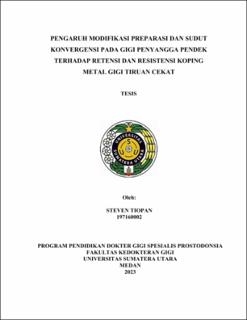| dc.contributor.advisor | Tamin, Haslinda Z | |
| dc.contributor.advisor | Nasution, M Indra | |
| dc.contributor.author | Tiopan, Steven | |
| dc.date.accessioned | 2025-05-15T02:25:08Z | |
| dc.date.available | 2025-05-15T02:25:08Z | |
| dc.date.issued | 2023 | |
| dc.identifier.uri | https://repositori.usu.ac.id/handle/123456789/103797 | |
| dc.description.abstract | Short abutment teeth that are planned for fixed denture restorations, can cause
problems such as the loosening of the fixed restorations. Loosening of the restorations
can be caused by inadequate retention and resistance factor. Retention is the quality
inherent in the dental prosthesis acting to resist the forces of dislodgment along the
path of placement, whereas resistance is the features of a tooth preparation that resists
dislodgment along an axis other than the path of placement. The retention and
resistance of fixed dentures greatly affected by the height of the crown, the angle of
convergence, and the surface area of the axial wall. The shorter an abutment tooth, the
retention and resistance of the fixed crown restoration will also decrease, proximal
preparation modifications can be made to increase retention and resistance. The
purpose of this study is to determine the effect of modification of preparation and
convergence angle of short abutment teeth on the retention and resistance of metal
copings of fixed denture teeth simultaneously. The research sample used was a
prepared brass rod with a height dimension of 3 mm and a width of 11 mm, with a
convergence angle of 10° and 22°. The preparation modifications used are groove or
box preparation modifications. A total of 30 samples were divided into 6 groups (n =
5) based on the angle of convergence and preparation modification. Testing the value
of retention and resistance using a universal testing machine (Torsee UTM AMU-10).
The results of the ANOVA test on the group with convergence angles of 10° and 22°
showed a value of p = 0.0001 which indicated the effect of preparation modification
on retention and resistance. On the Independent t-test, groove and box preparation
modifications with convergence angles of 10° and 22° showed a p value = 0.0001
which indicated an effect of preparation modifications on retention and resistance.
This is due to the effect of the groove and box preparation modification will increase
the surface area, increasing the adhesive surface area of the cement and the retention
value. In terms of resistance, additional groove and box preparation will add the effect
of mechanical interlocking that occurs between the metal coping and the metal
abutment, resulting in metal coping samples can only being released if there is damage
in the metal coping and/or abutment. From the results of this study, it can be concluded
that in cases with short abutment teeth, the addition of preparation modifications in
the form of grooves or boxes can significantly increase the retention and resistance
values. The box shaped preparation modifications will provide higher retention and
resistance values than the groove shaped preparation. | en_US |
| dc.language.iso | id | en_US |
| dc.publisher | Universitas Sumatera Utara | en_US |
| dc.subject | Short Abutment | en_US |
| dc.subject | Retention | en_US |
| dc.subject | Resistance | en_US |
| dc.subject | Groove and Box Preparation Modification | en_US |
| dc.title | Pengaruh Modifikasi Preparasi dan Sudut Konvergensi pada Gigi Penyangga Pendek terhadap Retensi dan Resistensi Koping Metal Gigi Tiruan Cekat | en_US |
| dc.title.alternative | The Effect of Preparation Modifications and Convergence Angle on The Retention and Resistance of Metal Copings in Short Abutments | en_US |
| dc.type | Thesis | en_US |
| dc.identifier.nim | NIM197160002 | |
| dc.identifier.kodeprodi | KODEPRODI12707#Prostodonsia | |
| dc.description.pages | 141 Pages | en_US |
| dc.description.type | Tesis Magister | en_US |
| dc.subject.sdgs | SDGs 3. Good Health And Well Being | en_US |


